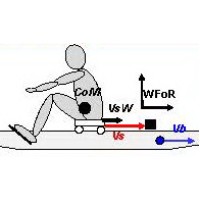Absolute seat movement

Did you know that absolute seat movements are more than two times smaller in magnitude than the boat movements? This implies that higher inertial rowing efficiency should be associated with a decrease in the variation of absolute seat velocity (and the rower’s mass), rather than the boat velocity.
The rower’s lower extremities may increase the boat 'deadweight' by more than double, consequently leading to increased inertial losses. Since calf muscles do not significantly contribute to rowing power, slimmer shins could be more effective in rowing. These and other findings were discovered in extended analysis of absolute seat movements.
In BioRow standard biomechanical testing, seat movement is measured using a position sensor mounted on the boat. This valuable data allows for the derivation of crucial indicators of rowing technique, such as Catch and Rowing Style factors, crew synchronization etc. The seat position is measured relative to the boat, but since the boat moves with a variable speed, it would be interesting to analyse the absolute seat movements relative to the stationary water or land – in the World Frame of Reference. This analysis could aid in optimizing technique because the seat is closely related to the rower’s Centre of Mass movements, and thus, to inertial forces and associated energy losses.
Two primary variables were measured directly and used in this analysis: boat acceleration. and seat position relative to the boat. The following derivatives were calculated:
- The relative boat velocity and displacement were obtained in a Local Frame of Reference, which moves with a constant velocity equal to the average rowing speed over the cycle. According to the Galileo relativity principle, the laws of mechanics work the same way in all inertial Frames of Reference, i.e., in those that move linearly with a constant velocity (assuming it is much lower than the speed of light).
- There were calculated the seat velocity and acceleration relative to the boat. Subsequently, the motions of the boat and seat were summed up to obtain the absolute seat displacement, velocity, and acceleration.
The amplitudes of boat and seat acceleration increase proportionally with the stroke rate, maintaining a nearly constant ratio. Specifically, the boat accelerates 2.2-2.3 times more than the seat.
According to our previous theory, the rower-to-boat ratio of absolute motions should be inversely proportional to the ratio of their masses. In this case, the mass ratio was 5.3 (95kg for the rower / 18kg for the boat with oars and measurement equipment). However, the ratios of displacement and velocity were much lower, ranging from 1.4 at 20spm to 2.6 at 39spm. This discrepancy could be explained by two factors:
- Some parts of the rower’s body connected to the stretcher (feet, partly shins, and thighs) move with the boat, associating their mass with the boat rather than the rower. A brief estimation using the full mass of the feet (2.8% of body mass), half of the shins (9.5%), and thighs (21.0%) results in 17.1kg, which should be subtracted from the rower’s mass and added to the boat. This adjustment yields a mass ratio of 2.21 (77.8 / 35.2kg), which is close to the mentioned ratio of movements.
- Oar rotation accumulates a portion of inertial energy and mitigates the variation in boat movements. When an oar changes direction at the catch, it pushes the gate forward and accelerates the boat at its lowest velocity. At the finish, the oar pushes the gate backward, slowing the boat down at its high velocity. This effect could explain the variation in the ratio of boat/seat motions at different stroke rates.
©2024 Dr. Valery Kleshnev
This is a brief contents iof the Newsletter.
To access the full text, please subscribe to BioRow membership here: http://biorow.com/membership/



